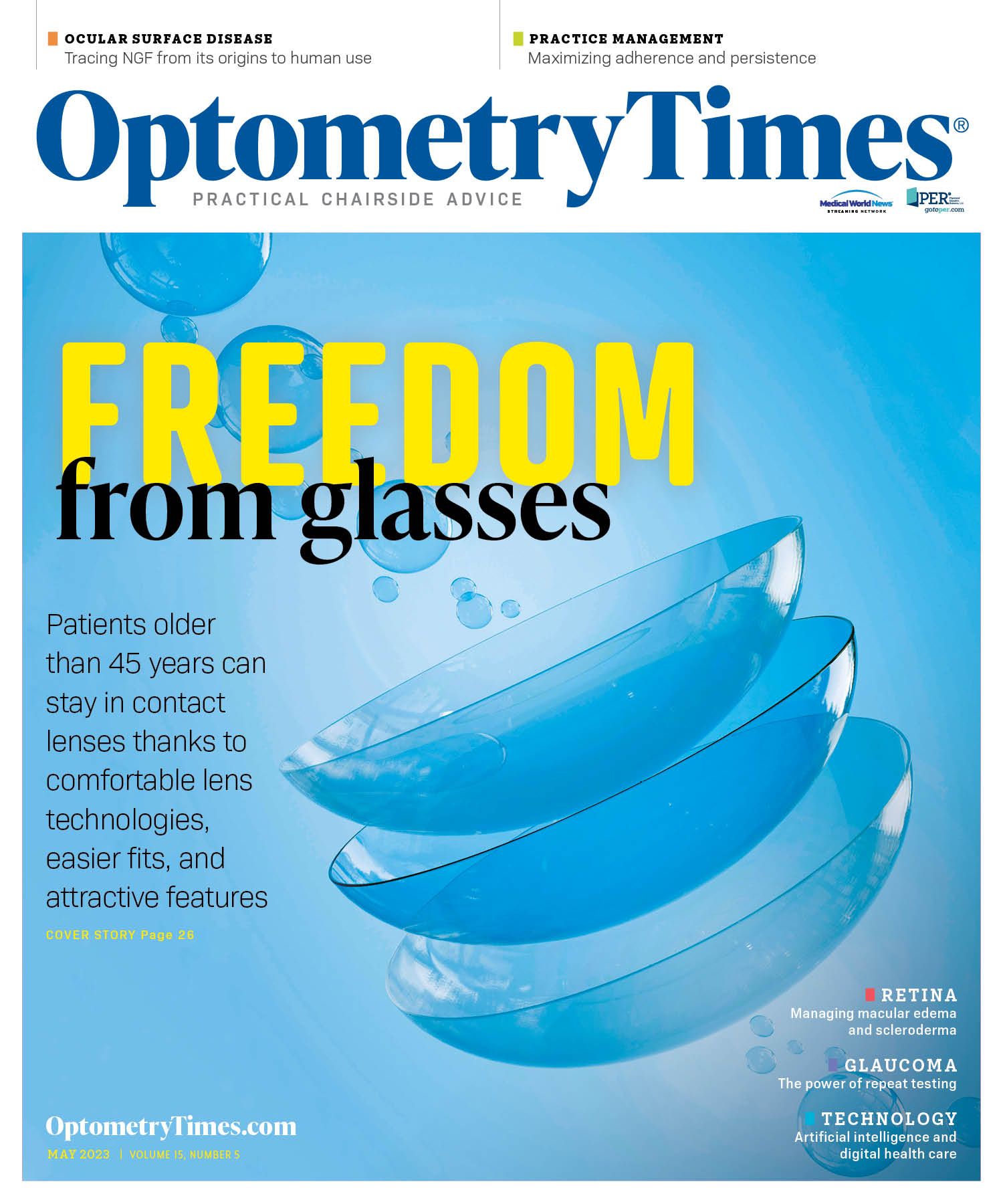- Therapeutic Cataract & Refractive
- Lens Technology
- Glasses
- Ptosis
- AMD
- COVID-19
- DME
- Ocular Surface Disease
- Optic Relief
- Geographic Atrophy
- Cornea
- Conjunctivitis
- LASIK
- Myopia
- Presbyopia
- Allergy
- Nutrition
- Pediatrics
- Retina
- Cataract
- Contact Lenses
- Lid and Lash
- Dry Eye
- Glaucoma
- Refractive Surgery
- Comanagement
- Blepharitis
- OCT
- Patient Care
- Diabetic Eye Disease
- Technology
Adherence and persistence: When patients take their health into their own hands
Both are critical to successful treatment, but how can optometrists help?
Both adherence and persistence are critical to optimize outcomes for conditions that we manage in our offices on a daily basis. (Adobe Stock/zinkevych)

Adherence has always been a challenge in health care. Adherence defines the degree or extent of conformity to the provider recommendations about day-to-day treatment with respect to timing, dosage, and frequency.1 Persistence refers to the act of continuing treatment for the prescribed duration.2 Both adherence and persistence are critical to optimize outcomes for conditions that we manage in our offices on a daily basis.
If a patient has a high level of persistence but low level of adherence to their treatment, they continue with the treatment but use the treatment incorrectly. This is common in contact lens wearers. Patients will be persistent with treatment by continuing to wear contact lenses but are often nonadherent with the regimen of cleaning, disinfecting, and appropriately maintaining their lenses. These patients persist with the treatment of contact lens wear but adhere poorly to the care regimen.
Problems with persistence come into play with chronic conditions that are less symptomatic. In these instances, patients expose themselves to treatments that may have unwanted adverse effects. These patients will discontinue therapy, reducing persistence to the intended treatment. Patients often lack an appropriate understanding of the condition that is being managed, and this may lead to poor persistence.
Glaucoma provides unique challenges. In early glaucomatous disease, patients usually show no symptoms of their condition. As such, introducing a medical therapy with potential adverse effects can threaten the persistence of therapy. It’s not surprising that the persistence with glaucoma medications in 2 recent studies is 54.6% and 60.9% after a year of therapy.3,4 This remarkably drops to 24.9% after 2 years of initiation of therapy.5
Opportunities to improve adherence to and persistence with therapy
Increased engagement with the patient about their condition is critical. This involves active education for the patient about their condition along with appropriate follow-up visits and diagnostic testing. In addition to helping more closely monitor their condition, it engages them throughout the process. Here we will discuss several conditions and how to optimize adherence to and persistence with treatment.
Age-related macular degeneration
Age-related macular degeneration (AMD) is a condition in which adherence to and persistence with therapy can be a concern. Early signs of the condition are often accompanied by few if any symptoms. Increasing educational efforts for patients can improve adherence and persistence efforts. Engaging patients in their care can also improve these efforts.
In a recent prospective controlled survey looking at adherence to the AREDS2 study recommendations, patients’ concordance rates with adherence were measured. In one clinic, there was a formal policy of giving the patient both verbal and written instructions and verbal repetition of these instructions from each staff member on each patient visit. In the second clinic, there was no specific education policy. The first clinic had a concordance rate of 81.6%, whereas the second clinic had a concordance rate of 44.1%.6
Follow-up visits for patients with AMD provide opportunities to assess the macula for change and improve adherence. Additionally, the evolution in home monitoring systems provides opportunities to engage patients in their care and assess change sooner. The ForeseeHome monitoring system, using preferential hyperacuity perimetry, was more likely to maintain vision over time compared with traditional means of monitoring vision.7-9
Another reason why this work on adherence and persistence early on is so important for patients with dry AMD is that if patients develop wet/neovascular AMD, their adherence and persistence are poor. In treatment-naïve patients, after getting started with anti-VEGF injections, 11.6% of patients were lost to follow-up and over 14% were nonpersistent (went over 6 months between visits).10
Glaucoma
In the United States, glaucoma cases continue to rise, with the number of projected cases of glaucoma estimated to affect 3 million individuals.11 Approximately 80% of these individuals have open-angle glaucoma, which is primarily managed with eye drops that patients self-administer at home.12 Adherence to and persistence with glaucoma therapy has been shown to be between 54.6% and 60.9%.3 The reasons for low medication adherence include lack of motivation, poor health literacy, denial, cognitive impairment, substance use disorder, cost, complexity of treatment, poor patient-provider relationships, and asymptomatic conditions.13
Glaucoma is typically asymptomatic until end-stage damage occurs, and research confirms that patient education can improve adherence with medication therapy.14 Overall, vision outcomes improve when patients take their medication, understand their condition, and have trusted relationships with their providers.15 Other methods shown to improve medication adherence include reminders with phone calls and phone-based applications.16 Moreover, there is evidence that patients with glaucoma may not return for follow-up appointments, but results in at least 1 study have shown that expanding the eye care team to include patient navigators and social workers improves follow-up care.17 Even home monitoring of intraocular pressure may further engage patients in their overall disease management and drive behaviors that provide more opportunity to educate and care for patients in helpful, meaningful ways.18
Contact lens wearers
Contact lens wearers are fortunate in that they live in a time where contact lenses are more comfortable and easier to use than ever before. Many prescriptions are currently available as daily disposables, and this helps optimize a patient’s adherence. The research is clear that those wearing daily disposable lenses are far more likely to wear their lenses according to the approved wearing schedule.19 This is likely due to a variety of factors, including fewer steps to care for the lenses, no solutions to keep track of, and the ease of simply disposing of the lens at the end of the day.
Many contact lens wearers can benefit from daily disposable lenses, offering opportunities to increase adherence. However, there are individuals who are not candidates for daily disposable lenses because of lack of power availability, an inability or unwillingness to pay for the higher cost of daily disposable lenses, or the simple preference to remain with their nondaily disposable lenses.
For patients wearing nondaily disposable contact lenses, calendars in phones have become a convenient way to help remind them when to replace their lenses. For monthly wearers, we suggest selecting a day in the month that is their replacement day and setting a reminder on that same day every month. For patients wearing lenses intended to be replaced every 2 weeks, we recommend selecting 2 days in the month that become their contact lens replacement days and therefore a recurring event in their calendar.
We take a very active role in the lens solutions our patients are using. We ask them to bring in their contact lens case, solution, and any other drops or products they use to care for their contact lenses. This allows us to give them direct recommendations on what they should be using for their lenses.
Increasing adherence with nutritional therapy
When we prescribe medications for patients, we have the pharmacy to aid in our adherence and persistence efforts. We provide the pharmacist with exact instructions on the medication, how to use it, and how long to use it.

When it comes to nonprescription therapies, it can be more difficult to monitor and encourage adherence and persistence with patients. An example of this is when nutritional supplementation is recommended to a patient. This is one of the reasons that clinicians have become increasingly involved in providing the appropriate therapies from their office. The benefit is that the patient’s adherence to and persistence with the recommended nutritional plan can be more easily monitored by the clinician at follow-up visits.
Additional efforts have been put in place by manufacturers of nutritional supplementation for ocular conditions. Patients can enroll in programs in which the desired nutrition product is sent directly to the patient’s house. The benefit is that the patient is supported by the company that produces the treatment.
Summary
Adherence and persistence efforts continue to be a challenge for clinicians when managing patients’ ocular conditions. It becomes increasingly challenging for asymptomatic conditions. As such, it is critical to leverage every opportunity to help patients better understand their conditions and deliver treatments adequately. In doing so, we will be sure to optimize adherence and persistence efforts.
References
1. Adherence. Merriam-Webster. Accessed April 18, 2023. https://www.merriam-webster.com/dictionary/adherence
2. Persistence. The Britannica Dictionary. Accessed April 18, 2023. https://www.britannica.com/dictionary/persistence
3. Iskedjian M, Covert DW, Walker JH. Persistence with prostaglandin agonist use with and without adjunctive therapy for glaucoma patients: a Canadian population-based analysis. Patient. 2011;4(2):133-141. doi:10.2165/11539460-000000000-00000
4. Kashiwagi K, Furuya T. Persistence with topical glaucoma therapy among newly diagnosed Japanese patients. Jpn J Ophthalmol. 2014;58(1):68-74. doi:10.1007/s10384-013-0284-2
5. Hwang DK, Liu CJL, Pu CY, Chou YJ, Chou P. Persistence of topical glaucoma medication: a nationwide population-based cohort study in Taiwan. JAMA Ophthalmol. 2014;132(12):1446-1452. doi:10.1001/jamaophthalmol.2014.3333
6. Weaver TRE, Beaumont PE. The effect of intensive education on concordance with the age-related eye disease study (AREDS) recommendations in a tertiary referral practice. Ophthalmologica. 2015;233(2):61-65. doi:10.1159/000366456
7. Chew EY, Clemons TE, Bressler SB, et al; AREDS2-HOME Study Research Group. Randomized trial of a home monitoring system for early detection of choroidal neovascularization home monitoring of the eye (HOME) study. Ophthalmology. 2014;121(2):535-544. doi:10.1016/j.ophtha.2013.10.027
8. Rao P, Lum F, Wood K, et al. Real-world vision in age-related macular degeneration patients treated with single anti-VEGF drug type for 1 year in the IRIS registry. Ophthalmology. 2018;125(4):522-528. doi:10.1016/j.ophtha.2017.10.010
9. Ho AC, Albini TA, Brown DM, Boyer DS, Regillo CD, Heier JS. The potential importance of detection of neovascular age-related macular degeneration when visual acuity is relatively good. JAMA Ophthalmol. 2017;135(3):268-273. doi:10.1001/jamaophthalmol.2016.5314
10. Khurana RN, Li C, Lum F. Loss to follow-up in patients with neovascular age-related macular degeneration treated with anti-vascular endothelial growth factor therapy in the United States in the IRIS Registry. Ophthalmology. 2023;S0161-6420(23)00132-X. doi:10.1016/j.ophtha.2023.02.021
11. Quigley HA, Broman AT. The number of people with glaucoma worldwide in 2010 and 2020. Br J Ophthalmol. 2006;90(3):262-267. doi:10.1136/BJO.2005.081224
12. Schwartz GF, Patel A, Naik R, Lunacsek O, Ogbonnaya A, Campbell J. Characteristics and treatment patterns of newly diagnosed open-angle glaucoma patients in the United States: an administrative database analysis. Ophthalmol Glaucoma. 2021;4(2):117-125. doi:10.1016/j.ogla.2020.09.002
13. Kleinsinger F. The unmet challenge of medication nonadherence. Perm J. 2018;22:18-033. doi:10.7812/TPP/18-033
14. McClelland JF, Bodle L, Little JA. Investigation of medication adherence and reasons for poor adherence in patients on long-term glaucoma treatment regimes. Patient Prefer Adherence. 2019;13:431-439. doi:10.2147/PPA.S176412
15. Gatwood J, Brooks C, Meacham R, et al. Facilitators and barriers to glaucoma medication adherence. J Glaucoma. 2022;31(1):31-36. doi:10.1097/IJG.0000000000001965
16. Boland MV, Chang DS, Frazier T, Plyler R, Jefferys JL, Friedman DS. Automated telecommunication-based reminders and adherence with once-daily glaucoma medication dosing: the automated dosing reminder study. JAMA Ophthalmol. 2014;132(7):845-850. doi:10.1001/JAMAOPHTHALMOL.2014.857
17. Leiby BE, Hegarty SE, Zhan T, et al. A randomized trial to improve adherence to follow-up eye examinations among people with glaucoma. Prev Chronic Dis. 2021;18:1-12. doi:10.5888/PCD18.200567
18. Che Hamzah J, Daka Q, Azuara-Blanco A. Home monitoring for glaucoma. Eye (Lond). 2020;34(1):155-160. doi:10.1038/S41433-019-0669-7
19. Rueff EM, Wolfe J, Bailey MD. A study of contact lens compliance in a non-clinical setting. Cont Lens Anterior Eye. 2019;42(5):557-561. doi:10.1016/j.clae.2019.03.001

